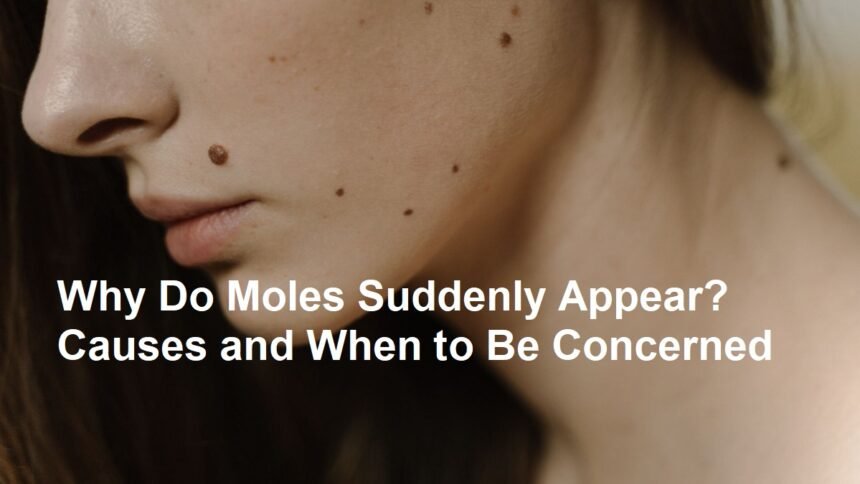Moles, medically known as nevi, are clusters of pigment-producing cells (melanocytes) that appear as small, dark spots on the skin. While most people develop moles gradually over time, the sudden appearance of a new mole can be surprising—and sometimes concerning. Understanding why moles form unexpectedly and knowing when to seek medical advice is key to maintaining skin health.
What Causes Sudden Moles?
- Genetics and Natural Skin Changes
Moles often develop due to genetic predisposition. If your family has a history of moles, you may notice new ones appearing throughout your life. Additionally, skin naturally evolves over time. Melanocytes can cluster due to hormonal shifts, sun exposure, or aging, leading to new moles even in adulthood. - Sun Exposure
Ultraviolet (UV) radiation from the sun or tanning beds is a major trigger for mole formation. UV light stimulates melanocytes, increasing pigment production and sometimes causing these cells to cluster. People with frequent sun exposure or sunburns often develop more moles, particularly on sun-exposed areas like the face, arms, and legs. - Hormonal Fluctuations
Hormonal changes during puberty, pregnancy, or menopause can activate melanocytes. Pregnant women, for example, may notice new moles or darkening of existing ones due to elevated estrogen levels. These “pregnancy moles” are usually harmless but should still be monitored. - Atypical Moles (Dysplastic Nevi)
Some moles appear suddenly due to abnormal melanocyte growth. Dysplastic nevi are irregularly shaped, larger-than-average moles that may resemble melanoma (skin cancer). While most are benign, they carry a slightly higher risk of becoming cancerous, especially in individuals with a family history of melanoma. - Skin Cancer Warning Signs
Rarely, a new mole may indicate melanoma or other skin cancers. Melanoma can arise from an existing mole or appear as a new, unusual-looking growth. Rapid changes in size, color, or texture warrant immediate medical evaluation.
When Should You Worry About a New Mole?
Most new moles are harmless, but certain features signal potential danger. Follow the ABCDE rule to assess moles:
- Asymmetry: One half doesn’t match the other.
- Border: Irregular, blurred, or jagged edges.
- Color: Multiple shades (brown, black, red, or white).
- Diameter: Larger than 6mm (about the size of a pencil eraser).
- Evolution: Changes in size, shape, or symptoms (itching, bleeding).
Other red flags include:
- A mole that looks drastically different from others on your body.
- Rapid growth or elevation above the skin’s surface.
- Pain, oozing, or crusting.
If a mole exhibits any of these traits, consult a dermatologist promptly. Early detection of melanoma significantly improves treatment outcomes.
Prevention and Monitoring
- Sun Protection: Wear broad-spectrum sunscreen (SPF 30+), protective clothing, and avoid peak UV hours (10 a.m.–4 p.m.).
- Regular Skin Checks: Examine your skin monthly for new or changing moles. Use a mirror for hard-to-see areas or ask a partner for help.
- Professional Screenings: Schedule annual skin exams with a dermatologist, especially if you have a family history of skin cancer or numerous moles.
Can You Remove a Sudden Mole?
Most moles don’t require removal unless they’re suspicious or bothersome. Dermatologists can remove moles via:
- Shave Excision: Shaving off the mole with a scalpel (for surface-level moles).
- Surgical Excision: Cutting out the mole and stitching the skin (for deeper moles).
- Laser Removal: Breaking down pigment (for small, non-cancerous moles).
Never attempt DIY mole removal, as this can lead to infection, scarring, or missed cancer diagnosis.
The Bottom Line
The sudden appearance of a mole is usually harmless, driven by genetics, hormones, or sun exposure. However, vigilance is crucial. Monitor new moles for abnormal changes and prioritize sun protection to reduce future risk. When in doubt, always seek a professional opinion—it’s better to err on the side of caution with your skin health.
By understanding the causes and warning signs, you can confidently distinguish between a benign skin quirk and a potential health threat.












